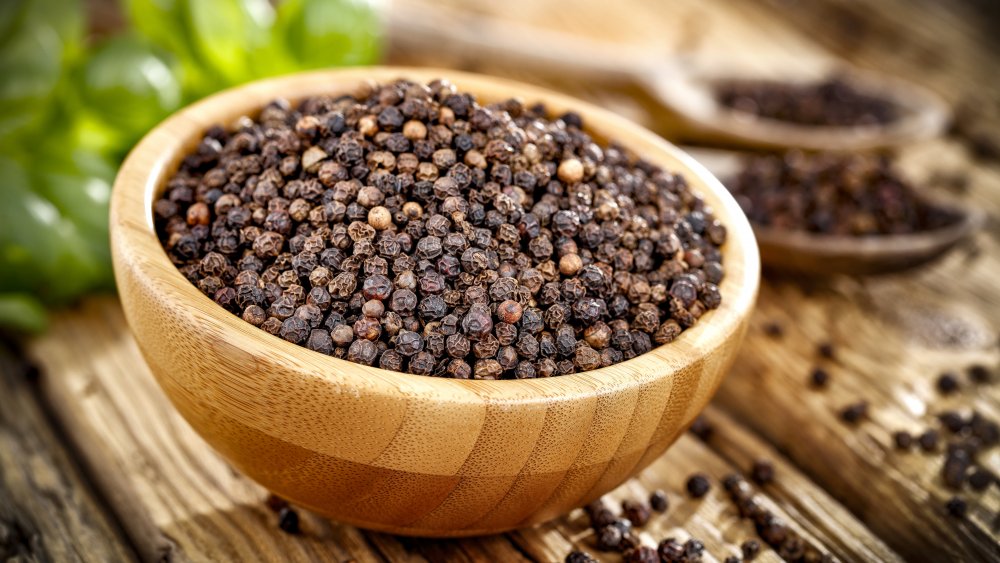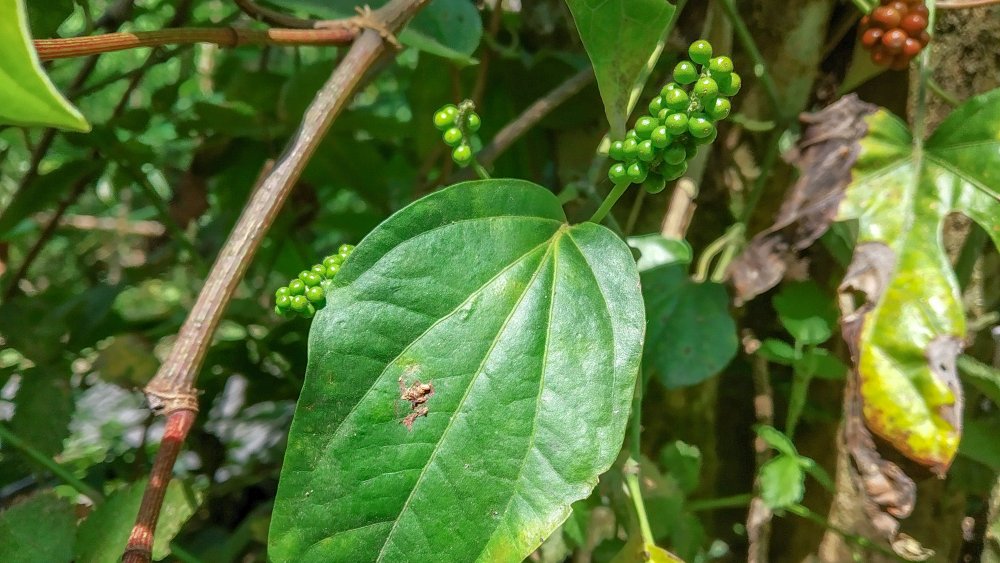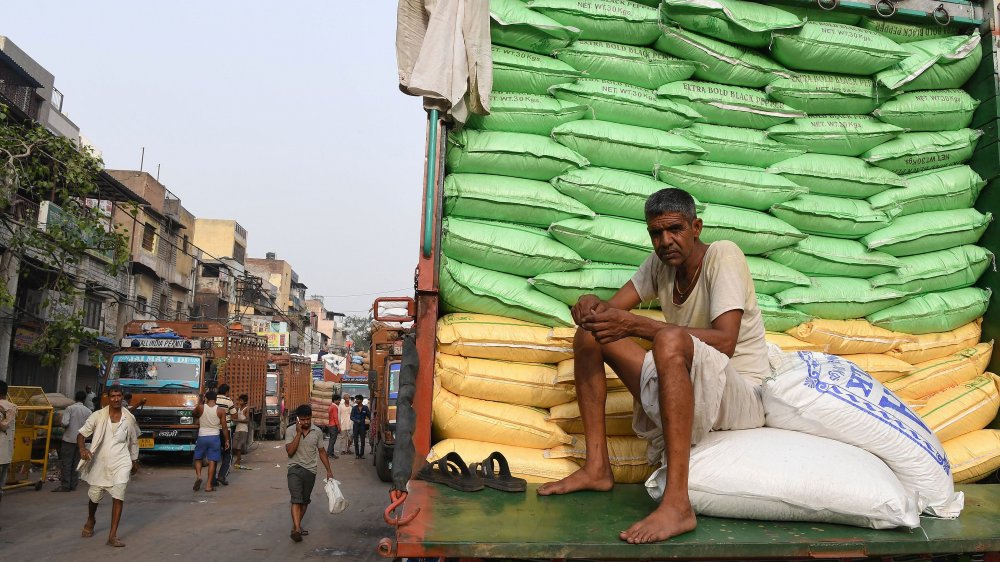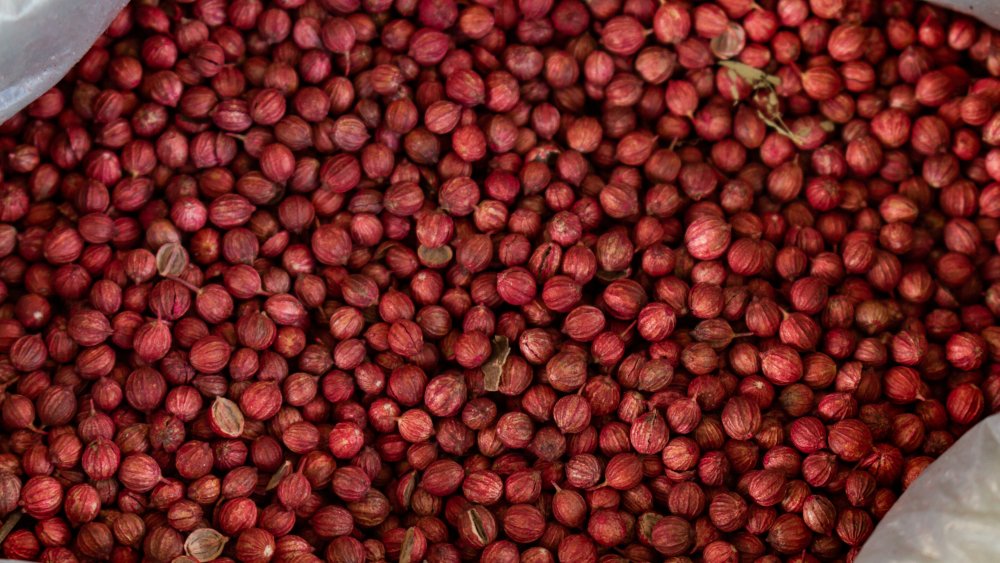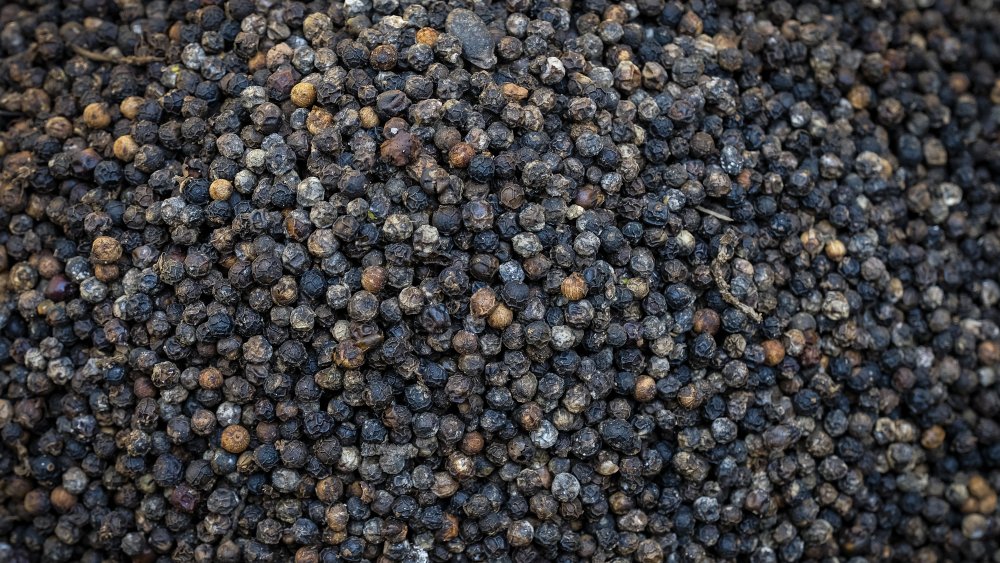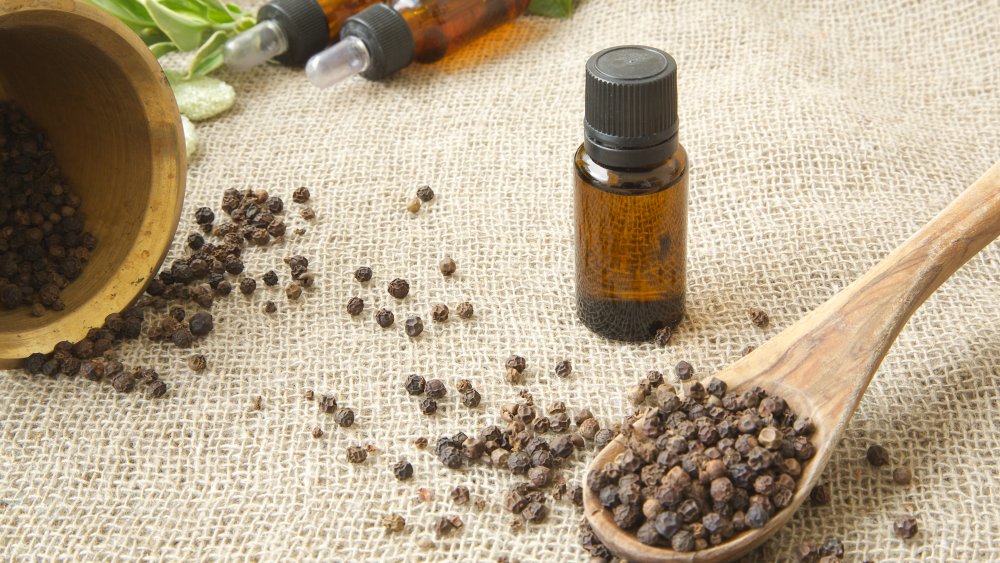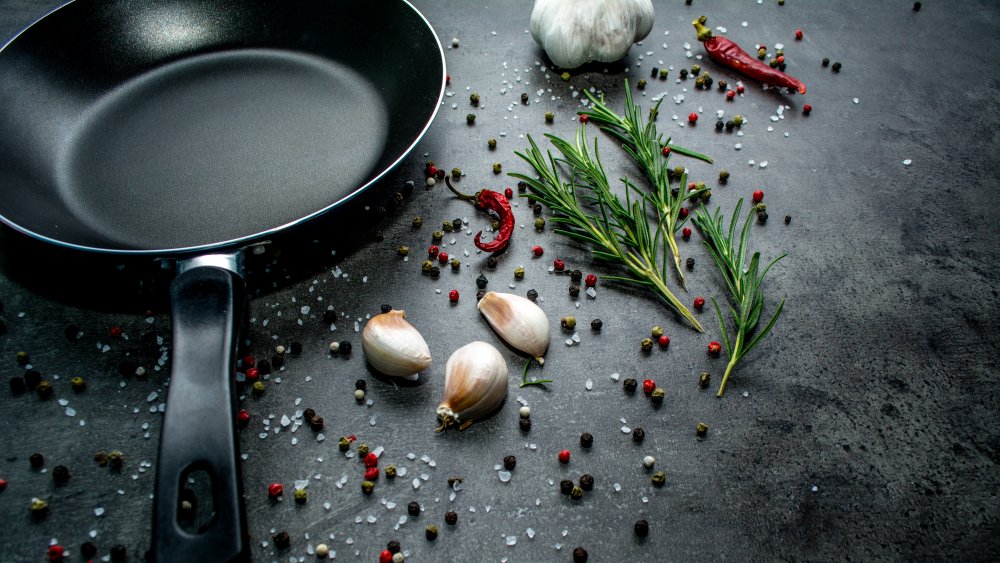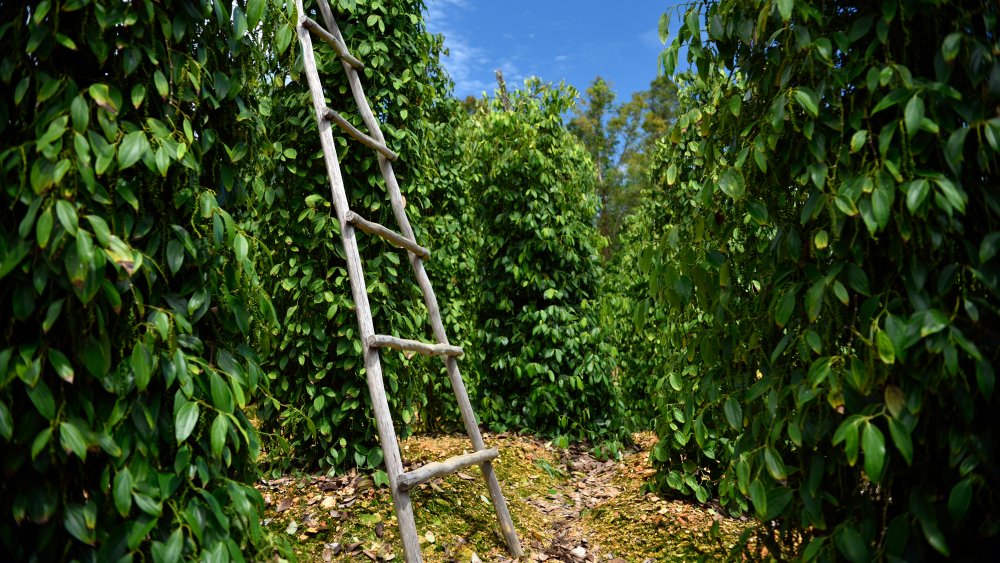The Untold Truth Of Pepper
Honestly, it's hard to think much of black pepper. Despite being largely ubiquitous in every kitchen and practically every restaurant, this spice doesn't exactly seem like the most exciting thing in the world. But you'd be surprised; just because this stuff is everywhere doesn't mean it's not fascinating. In fact, the so-called "King of Spices" isn't just one of the most useful and versatile tools for cooks — it's also wrapped up in a genuinely fascinating history, and comes with a great number of benefits... as well as a few useful applications beyond the kitchen, too.
Sure, it may not be as glamorous as, say, saffron, or cumin, or rosemary... or pretty much any other spice. And it's nowhere near as beloved as salt, either. But hey, give it a chance. From its faraway roots, to its many-colored cousins, to its weird and wonderful healing properties, here's the untold truth of black pepper.
What is pepper?
Let's start at the top. The peppercorns that we all know so well as "black pepper" actually come from a flowering vine in the Piperaceae family of plants. Pepper vines are native to India, but these days they're found and cultivated all around the world; Vietnam grows and exports about 35 percent of the world's supply of black pepper, with Indian, Brazil, China and Sri Lanka making up much of the rest.
These leafy, green plants grow their fruits on tendrils, which are each made up of a skin, fruit and a large seed. These fruits are picked when the time is right — with the best black pepper being made from berries that have only just turned orange. The berries are removed from their stems before being blanched in boiling water for 10 minutes. They're then dried quickly in direct sunlight until they become black and wrinkled. Next, they're graded by size, color and density, and then shipped off for packaging.
This may sound simple enough, but it's hard to understate the scale of this process. Black pepper makes up a whopping 20 percent of the world's total spice trade, and the industry as a whole brings in billions and billions of dollars every year. That's a lot of tiny pepper berries to move through this long process.
Pepper has a long history
Archaeologists have found evidence of people in India using pepper as far back as 2000 B.C. It appears that there existed some kind of pepper trade between India and Egypt after this, since peppercorns were stuffed into Ramses the Great's nostrils during mummification.
A couple of thousand years later, the Romans were making a fair bit of bank out of exporting peppercorns out of India. And the Romans really loved the stuff, too: When Rome was besieged in 410 A.D., the city's rulers even offered the Visogoths three thousand pounds of pepper (among other things) in a desperate and futile attempt to avoid being sacked.
After the fall of Rome, the Arab world came to dominate the pepper trade, and by the 10th century the spice had become well-loved among Europe's royal families and aristocracies. Before long, however, other traders had figured out where the Arabs were getting their pepper from, and soon Portuguese, Genoan and Venetian merchants began to tighten their grip on the industry. Pepper didn't exactly get cheaper for this, though, and even in the High Middle Ages, pepper was a hugely valuable spice which came with an astronomically high price for the consumer, largely because moving it from India to the West required the efforts of so many middlemen.
Control of the spice trade later switched hands again, first to the Dutch and then the British. Today, things are much different, and pepper is produced and exported by various nations all over the world.
Pepper is losing ground in India
Despite being the original home of black pepper back during antiquity, it seems like India's golden age of pepper production may be long-gone. Thanks to oversupply in the global market and a rise in pepper imports from different countries around the world, the price of the spice in India hit a decade low-point in late 2019. Between 2017 and 2019, pepper had lost more than half of its value in the country.
According to Indian pepper exporters, much of the country's pepper is now coming from elsewhere, such as Mumbai, Chennai and Tuticorin — and this is the major cause for the fall in Indian pepper prices. The Indian government attempted to prevent this by implementing a minimum import price for black pepper in 2017, but this has been largely flouted and ignored by black pepper exporters from other countries. Not only this, but production of black pepper in India has fallen drastically in the last few years, thanks largely to heavy rains and flooding, meaning more Indians are looking to overseas imports to acquire their black pepper for domestic use. As a result of these issues (and the freefall in prices), many Indian farmers have switched to growing crops such as cardamom.
Where once India was prized and fought over for its production of black pepper, it now looks like the spice's days in the region are numbered.
The other kinds of pepper
Of course, black pepper isn't the only kind of pepper out there. Otherwise you wouldn't need to quantify it as "black" pepper, would you? There are, in fact, almost half a dozen other varieties of peppercorns, each made by harvesting the plant in a different way. White pepper is the more mature version of the fruit, which is ripened to a red color before picking. This kind of pepper is milder than black pepper, and is frequently found in Asian cuisine — or in lighter-colored dishes, for aesthetic reasons.
Green peppercorns are picked from orange/red berries just like black peppercorns, but are not dried before storage. Instead, they're pickled in vinegar or brine, or freeze-dried and dehydrated in order to give a less intense and concentrated taste. You've also got the rarer red peppercorn, a mature, fully-ripened and unhulled version of the peppercorn that is about as expensive as it is hard to find.
There are also a couple of berries that go by peppercorns but are unrelated to Piperaceae fruit. Pink peppercorns come from the Baies rose plant, which is found in Madagascar. These are a little sweeter but less flavorful than normal peppercorns. Pink berries, also sometimes known as pink peppercorns, come from the Peruvian or Brazilian pepper tree, and gives a kind of sweet, menthol-type flavor. It can also cause allergic reactions and is often toxic in large quantities. So, yeah, not great for soup.
All black pepper is still not the same
As you might expect, different black peppercorns from different countries and producers tend to have varying qualities. Take this taste test by Serious Eats, for example. The publication lined up a number of different kinds of black peppercorn from a range of countries, including Indonesia, India, Brazil, Vietnam, Malaysia, and Ecuador, judging the acidity, sweetness, flavor, texture and general quality of each. In the end, each kind of peppercorn varied wildly, and there was little correlation between flavor and aroma, meaning you've got a range of options to choose from depending on whether you're looking for stronger or weaker aromas or tastes.
Indonesia's Lampong peppercorns were noted to have strong, citrusy aromas and a slow burn that evolved into a more intense heat; perfect for a ribeye steak. India's Tellicherry peppers came off as sweet, with a fresh taste and fruity, grassy notes. Brazil's peppercorns had a "brash intensity" and a "pungent, nose-clearing bite [that] gives way to a more mild, easygoing flavor." Ecuador's Talamanca peppercorns, meanwhile, gave off a "slow chili-like heat" with smoke aromas and a bitter finish.
Serious Eats tested more peppercorns, but it's clear enough from just these few how much range you can get from different pepper producers. As with anything, it's always worth experimenting to see which kind is right for you.
Pepper in health and medicine
Everyone knows pepper tastes great on the right dish, but what about the health benefits? Just what can black pepper do for you? Well, this spice wasn't just prized as a culinary tool by the ancients — it was also used as a medicine. For example, it was used in Indian Ayruvedic medicine to cure constipation, earache, gangrene and heart disease. Hippocrates, in Ancient Greece, used it for healing purposes, while the Chinese used it as a treatment for epilepsy.
But today a little more is known about the beneficial properties of black pepper. Much of these come from piperine, the active ingredient in peppercorns. This stuff can aid digestion by stimulating the production of hydrochloric acid in the stomach, strengthen the digestive tract, boost the body's ability to absorb curcumin, and can even prevent stomach ulcers, thanks to its anti-inflammatory and antioxidant properties.
Some research has also shown that black pepper can prevent the build-up of body fat and enhance metabolic performance, while piperine has been shown to boost cognitive function and reduce memory impairment. It has also been suggested that this stuff can reduce pain and inflammation caused by arthritis. To fully enjoy the effects of black pepper, however, you might want to look into buying black pepper powder or essential oil rather than just doubling up on table pepper for your next dinner, since these products can be more conveniently applied to your daily routine. Nobody likes an over-peppered stew, no matter how un-arthritic it makes them.
Black pepper in the kitchen
So here's the slightly-less-than-million-dollar question: how do you use black pepper in the kitchen? Sure, you can just grind it mindlessly on top of any dish you like, but what's the right way to use it? How can you best utilize it to make your recipes really crackle?
Well, Epicurious says there are a few different ways to use black pepper. The first thing they suggest is simply using more; cranking things up a notch by simply using it more readily and liberally than you might have in the past. They also suggest grinding peppercorns so they're coarse, rather than fine, as a way to retain flavor and stop yourself from choking when you step up your use of the spice. They also suggest using peppercorns as a coating, allowing them to stick to a food such as chicken cutlets, fried cauliflower florets, or strips of bacon — and vastly increase their flavor.
Black pepper is great in your garden
You already know what pepper is good for in the kitchen — but it's actually useful for far more than just spicing up your dinner. In fact, black pepper has a range of different applications around the house. For example, it can be used as a pesticide by gardeners to protect their plants. Black pepper works as a pesticide within 24 hours and has even been found by some research to be more effective than certain synthetic pesticides. Even better, it poses no threat to humans or animals beyond the insects you're trying to get rid of — although household pets don't like the smell of the stuff, so it's a safe way to keep them away from plants, too.
Black pepper also keeps ants away, because it contains a chemical known as capsaicin that naturally repels ants. All you need to do is sprinkle some black pepper (or spray a solution of pepper in warm water) onto your plants and you'll be ant-free and happy. The real bonus here, though, is that black pepper also works as an antibacterial agent, so it'll protect your plants against fungus and bacterial infections. Just mix it into the soil, and the plant will absorb the black pepper compounds, giving it a fighting chance against any nasty bacteria that show up looking for trouble.
Black pepper can help with car repairs
If you're less green-fingered and more oily-fingered instead, you might like to know that black pepper has a role in car repairs. If the radiator on your car's engine is leaking, black pepper can be used to plug that leak. As long as the leak isn't too big, introducing black pepper to your car's system will cause the particles to travel to the leak, where they will expand and seal it. Since the pepper doesn't deteriorate, you can leave it there (for a reasonable amount of time) until it gets seen by a professional.
First, remove the lid from the radiator once the engine is cool. Then pour a tablespoon into the radiator itself via the radiator cap opening. After that, you'll need to fill the radiator with a 50/50 mix of antifreeze and water, before driving the car for around 15 minutes to bring the radiator temperature to its operating level. Give it half an hour or so for the pepper particles to swell, then check the radiator for leakage. With any luck, it should be all sealed up.
The coarser the pepper the better for this, since you want your particles to be large and able to expand easily. We know this sounds too crazy to believe, but commenters in several online forums have said they found success with this method, at least temporarily. If your radiator is still leaking, however, you should probably take your car into a professional repair shop — and maybe don't tell them that you tried to fix your broken car based on a method you found on a food website.
Black pepper can help with the laundry
Sure, not everyone is a gardener, and we can't all repair a car. But everyone needs to wash their clothes, right? Luckily, pepper has a use here, too: it can keep your fabrics' colors bright and prevent fading.
See, clothes often fade in color because of residual soap leftover from the wash. Remove that soap, and you'll prevent fading. All you need to do is add a teaspoon of ground black pepper to your wash along with the detergent you normally use. (Make sure to add it to the main compartment, by the way, rather than your machine's detergent drawer). Then run it on a cold cycle. The pepper will work like sandpaper to draw out that soap from the clothes during the wash, and your clothes will remain nice and bright.
For what it's worth, salt, vinegar, lemon and coffee will do pretty much the same thing, but you're not here for salt, vinegar, lemon or coffee, are you? You're here for black pepper. King of Spices, yo.
How to become a pepper farmer
Just in case you'd rather not buy your pepper from the grocery store (or from clandestine traders flouting your country's import laws), here's an idea: why not grow it yourself?
Well, because you probably can't, actually. Unfortunately, pepper vines only thrive in moist, humid conditions, and few places in the United States are suitable to cultivate them. Still, with a little patience and some decent resources, you can give it a good go. Peppercorn seeds are readily available online, and if you live in a warm climate you can plant them outdoors in any protected area with some nice partial shade. You're going to need some rich, moist soil, though, as well as a regular air temperature of above 60 degrees Fahrenheit. If you don't have that, plant your peppercorns in large pots and move them indoors during the winter, or keep them in a greenhouse all year round. You're also going to need a large structure or trellis for the vines to spread across, as well as bright light and regular moisture.
If you're lucky, you'll soon see the literal fruits of your labor. Once they're at the level of ripeness you require, pick them, separate them, and dry them in the sun or a food dryer. Once they're black and dry, you can move them to the kitchen. It's not an easy process, sure, but it's all the more rewarding if you succeed.
